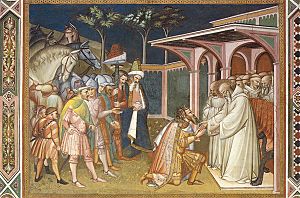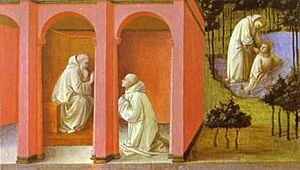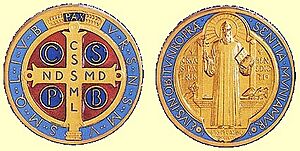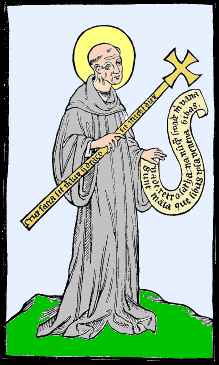Benedict of Nursia facts for kids
Quick facts for kids SaintBenedict of Nursia OSB |
|
|---|---|

A portrait of Saint Benedict as depicted in the Benedetto Portinari Triptych, by Hans Memling.
|
|
| Founder of the Benedictine Order, Exorcist, Mystic, Abbot of Monte Cassino, and Father of Western Monasticism | |
| Born | 2 March 480 Nursia, Kingdom of Italy |
| Died | 21 March 547 (aged 67) Mons Casinus, Eastern Roman Empire |
| Venerated in | All Christian denominations which venerate saints |
| Canonized | 1220, Rome, Papal States by Pope Honorius III |
| Major shrine | Monte Cassino Abbey, with his burial Saint-Benoît-sur-Loire, near Orléans, France |
| Feast | 11 July (General Roman Calendar), (Anglican Communion) 14 March (Eastern Orthodox Church) 21 March (pre-1970 General Roman Calendar) |
| Attributes |
|
| Patronage |
|
Saint Benedict of Nursia (born around 480 AD – died around 547 AD) was an important Christian monk, writer, and thinker from Italy. Many Christian groups, like the Catholic Church and Eastern Orthodox Church, honor him as a saint. He is even considered a patron saint of Europe.
Benedict started twelve communities for monks in Italy, near Rome. Later, he moved to Monte Cassino in the mountains. The Order of Saint Benedict is a group of monasteries that follow his teachings. It's not a single "order" like some others, but more like a family of independent communities.
Benedict's most famous work is his Rule of Saint Benedict. This book contains a set of guidelines for monks to live by. It teaches balance, moderation, and being reasonable. Because of its wise advice, many Christian communities in the Middle Ages adopted his Rule. It became one of the most important religious guides in Western Christianity. People often call Benedict the founder of Western Christian monasticism.
Contents
Who Was Saint Benedict?
Learning About Benedict's Life
Most of what we know about Saint Benedict comes from a book called Dialogues. It was written by Pope Gregory I around 593 AD. This book isn't a modern biography. Instead, it shares stories and miracles about Benedict to teach spiritual lessons.
Pope Gregory said he got his information from people who knew Benedict well. These included some of Benedict's own students and followers. They lived with him and saw the amazing things he did.
Benedict's Early Life and Studies
Benedict was born into a noble Roman family in Norcia, Italy. He had a twin sister named Scholastica. When he was about 20 years old, he went to Rome to study. However, he didn't like the way people lived there.
He decided to leave the city to find a quieter place. He took his old nurse with him. They settled in a town called Enfide, which is now known as Affile. It was about 40 miles from Rome.
Near Enfide, Benedict found a narrow valley that led to Subiaco, Lazio. He discovered a cave high up on a mountain. This cave became his home.
Becoming a Hermit
On his way to the cave, Benedict met a monk named Romanus of Subiaco. Romanus lived in a monastery nearby. Romanus helped Benedict and gave him a monk's robe.
Benedict then became a hermit, living alone in the cave for three years. No one knew he was there except Romanus. Romanus would visit him and bring him food on certain days. During this time, Benedict grew wiser and stronger in his faith.
Leading Monasteries
After three years, people in the area started to know about Benedict. They respected him greatly. When the leader of a nearby monastery died, the monks asked Benedict to become their new abbot (leader).
Benedict knew that his way of life was different from theirs. He worried they wouldn't get along. But he agreed to help them. The monks, however, tried to poison him. The story says they tried to poison his drink. When he prayed over the cup, it shattered.
He left that group and went back to his cave in Subiaco. Another priest, named Florentius, became jealous of Benedict. He tried to poison Benedict with bread. When Benedict prayed over the bread, a raven flew in and carried the loaf away.
After these events, many people came to Subiaco to learn from Benedict. He founded 12 monasteries in the area. Around 530 AD, he founded the famous Monte Cassino monastery. It is located on a hilltop between Rome and Naples.

Even a powerful king, Totila of the Ostrogoths, heard about Benedict. Totila tried to trick Benedict by sending a general dressed in his royal robes. But Benedict immediately knew it wasn't the king. Totila then came to show Benedict proper respect.
Saint Benedict's Legacy
Death and Veneration
Saint Benedict is believed to have died from a fever at Monte Cassino. This happened not long after his twin sister, Scholastica, passed away. They were buried in the same place. Tradition says he died on March 21, 547 AD.
In 1964, Pope Paul VI named him a patron protector of Europe. Later, in 1980, Pope John Paul II declared him a co-patron of Europe. He is also the patron saint of cave explorers and farmers in some places.
His feast day is celebrated on July 11 in the General Roman Calendar. The Eastern Orthodox Church remembers him on March 14. Many Anglican Communion churches also celebrate him on July 11.
The Rule of Saint Benedict
Benedict wrote his Rule around 516 AD. It was for monks who lived together under the guidance of an abbot. The Rule has 73 short chapters. It offers both spiritual wisdom and practical advice for running a monastery.
More than half of the chapters talk about being obedient and humble. They also explain what to do if a monk doesn't follow the rules. About a quarter of the chapters are about the "work of God," which includes prayer. A smaller part explains how the monastery should be managed.
The Rule follows a famous saying: Ora et Labora, which means "pray and work." Monks would spend eight hours praying, eight hours sleeping, and eight hours doing manual work, reading, or helping others.
The Saint Benedict Medal
The Saint Benedict Medal is a special religious item. It started from a cross honoring Saint Benedict. One side of the medal shows Saint Benedict holding his Rule and a cross. A raven and a cup are also shown. Around the edge, it says, "May we be strengthened by his presence in the hour of our death."
The other side of the medal has a cross with letters. These letters stand for Latin phrases like "May the Holy Cross be my light" and "Let not the dragon be my guide." Other letters on the cross mean "The Cross of the Holy Father Benedict." Around the edge of this side, there are letters that stand for "Begone Satan, do not suggest to me thy vanities; Evil are the things thou profferest, drink thou thine own poison." This is a prayer known as Vade Retro Satana.
This medal was first made in 1880 to celebrate 1,400 years since Benedict's birth. Its exact beginning is a bit of a mystery. In 1647, during a witchcraft trial, some accused women said they couldn't harm a certain abbey because it was protected by a cross. Later, crosses with these special letters were found at the abbey. A manuscript from 1415 helped explain the meaning of the letters. The medal then became popular across Europe.
Benedict's Impact on Europe
The early Middle Ages are sometimes called "the Benedictine centuries." In 2008, Pope Benedict XVI spoke about how much Saint Benedict influenced Western Europe. The Pope said that Benedict's life and work greatly helped European civilization and culture grow. He helped Europe recover after the fall of the Roman empire.
Benedict played a huge role in the rise of monasticism in the West. His Rule became the basic guide for thousands of religious communities during the Middle Ages. Even today, the Rule of St. Benedict is still the most common and important guide for monasteries and monks.
The church built where Benedict and Scholastica were born was badly damaged by an earthquake in 2016. Only the front and altar remained standing.
Images for kids
-
Statue in Einsiedeln, Switzerland
See also
 In Spanish: Benito de Nursia para niños
In Spanish: Benito de Nursia para niños
- Anthony the Great
- Saint Scholastica (St. Benedict's twin sister)
- Benedictine Order
- Saint Benedict Medal
- Vade retro satana












